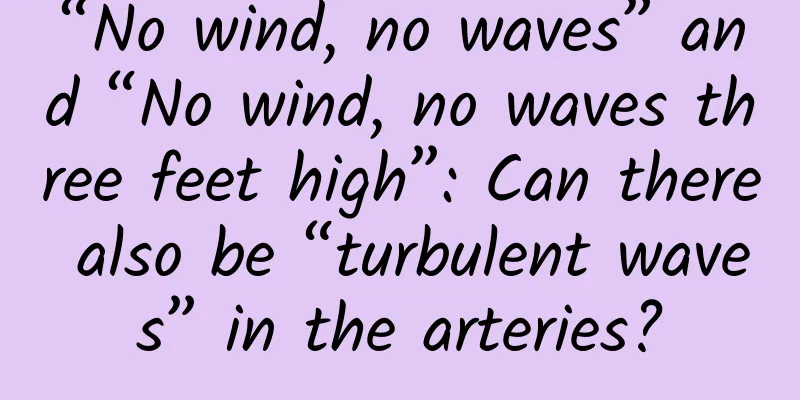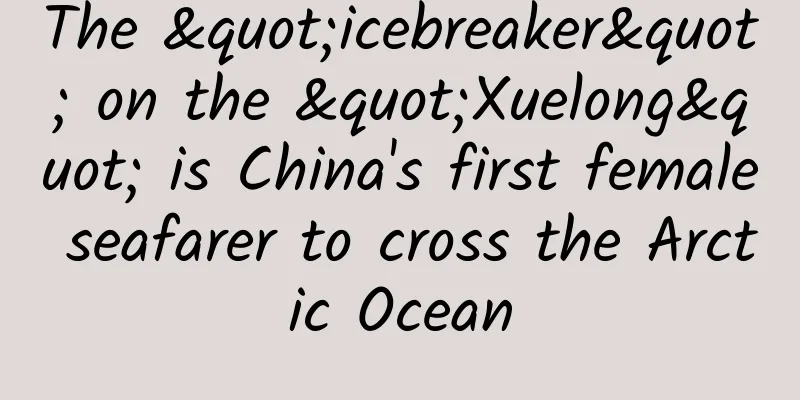“No wind, no waves” and “No wind, no waves three feet high”: Can there also be “turbulent waves” in the arteries?

|
"No wind, no waves" and "No wind, no waves" are common sayings in daily life. These two seemingly contradictory sayings actually have their own scientific truths. This reminded me that there is also an "ocean" in our body - the sea of blood flowing in the circulatory system, which is also "turbulent". Today, let us embark on a special "ocean journey" to explore the mystery of the propagation of pulse waves in the arterial system and see how it is similar to the formation of waves in the ocean. 1. The scientific reasoning behind “No wind, no waves” and “No wind, three-foot waves” 1. The scientific reason why “there is no wind without waves” From the perspective of energy transfer, ocean waves are mainly formed by the energy provided by wind. When the wind blows over the sea surface, it transfers energy to the seawater. When the wind blows over the sea surface, friction (i.e., viscous shear force) is generated between the wind and the surface of the seawater. This force "rubs" the seawater like a big palm. And "fluids do not rub" is an important characteristic of fluids. When the wind exerts this "rubbing" force on the seawater, the seawater will move and small ripples will appear on the sea surface. If the energy of the wind is small, it can only cause slight fluctuations on the surface of the seawater - as the crosstalk "Eight Screens" says, "The wind blows layers of waves on the water surface" (Figure 1). As the wind force increases, the energy transferred to the seawater by the wind increases, and the height and wavelength of the waves will increase accordingly. Figure 1 The "rubbing" of the water surface by the wind causes "layers of waves on the water surface" From the perspective of wave theory, wind is the external driving force of waves. The pressure difference caused by wind on the sea surface is the key factor in the formation of waves. When the wind blows over the sea surface, a low-pressure area will form on the leeward side of the sea surface, while the windward side will be a relatively high-pressure area. This pressure difference causes the seawater to flow from the high-pressure area to the low-pressure area, thus forming waves (Figure 2). Moreover, the duration and intensity of the wind determine the duration and size of the waves. If the wind blows steadily over the sea surface for a long time, the waves will continue to accumulate energy and become more turbulent. Figure 2 Pressure difference drives seawater to form waves 2. The scientific reason for “there are three-foot waves even when there is no wind” Consider the factors of seafloor topography and ocean currents. Even without wind, changes in seafloor topography can cause waves. For example, in shallow waters, when there are ridges or depressions in the seafloor topography, the flow of seawater will be disturbed. Undersea mountains will cause the seawater to surge upward, forming waves (Figure 3). Just as reefs in rivers cause waves in the water, irregularities in the seafloor topography can cause the seawater to fluctuate. Ocean currents also affect waves. When ocean currents of different temperatures and salinities meet, they create density differences, which cause the seawater to flow and fluctuate. For example, where cold and warm ocean currents meet, the movement of the seawater is more complex, resulting in larger waves. Figure 3 Undersea mountains cause the sea water to surge upwards, forming waves Consider the propagation of distant wind and waves. The oceans on Earth are interconnected entities. Waves generated in distant seas can propagate to windless seas. When waves propagate in the vast ocean, their energy is preserved to a certain extent. For example, around some islands in the Pacific Ocean, even if there is no wind locally, waves propagating from the center of a distant storm can still reach here, causing waves on the sea surface around the islands. Moreover, during the propagation process, waves will undergo refraction, reflection and other phenomena, which will also change the shape and size of the waves, resulting in waves even when there is no wind. Consider astronomical and geographical factors such as tides, earthquakes, and tsunamis. Tides are the periodic rise and fall of seawater caused by the gravitational interaction between the earth, the moon, and the sun. During the rise and fall of tides, the seawater undergoes large-scale horizontal movement, thus generating waves. Even without the influence of wind, when the tide rises and falls, the seawater will rush to the coast or retreat from the coast to the sea, and waves will be formed in this process. For example, during the Qiantang River high tide, huge tidal water rushes into the narrow river channel. As the river channel narrows, the energy of the tidal water is concentrated, forming a very high wave head (Figure 4). The formation of this wave is mainly due to the action of tidal force, not wind. In addition, submarine earthquakes are one of the main causes of tsunamis. When an earthquake occurs on the seabed, the movement of the earth's crust instantly releases huge energy, causing violent disturbances in the water body on the seabed. This disturbance propagates outward in the form of tsunami waves. Tsunami waves are extremely fast in the deep sea, with long wavelengths but relatively small wave heights. When tsunami waves approach the coast, the wave height increases sharply due to the shallowing of the sea water, forming huge waves. The generation of such waves has nothing to do with wind, but is entirely caused by crustal movement caused by submarine earthquakes. For example, the tsunami caused by the Fukushima earthquake in Japan in 2011 had waves as high as tens of meters, causing great disasters to coastal areas. Figure 4 Qiantang River Tide In addition, changes in atmospheric temperature and pressure and the movement of large objects such as ships can cause waves. 2. The “turbulent waves” in the human body The reason why the blood circulation system can transport blood to the whole body is because it has a "power pump", which is our heart; and the intricate network of blood vessels is like a "river". There is also a "turbulent" phenomenon in the circulatory system, which is the pulse wave. 1. “No wind, no waves” in the arteries "No wind, no waves" is a common sight at the seaside. The sea breeze sweeps across the sea, like a pair of invisible hands rubbing the sea water, causing waves. In the human body, the operation of the heart is like the sea breeze, which drives the blood flow. The heart, a tireless "power pump", contracts strongly during the systolic period, pumping blood rapidly into the arterial system (Figure 5). This force is like the initial power given by the sea breeze to the seawater, causing the blood to begin its "journey" in the arteries, thus generating the initial pulse wave. Studies have shown that the amount of blood ejected by the heart each time it contracts is about 60-80 ml, which is enough to cause the aortic wall to begin to expand, just like the ripples on the sea surface caused by the sea breeze, which opens the first step in the propagation of the pulse wave. Figure 5 The heart pumps blood into the vascular system As the wind gets stronger, the waves get more violent. Similarly, changes in the heart's contractile force will affect the intensity of the pulse wave. When we exercise, the heart needs to work harder, the contractile force increases, the blood pressure rises, and the intensity of the pulse wave increases accordingly. It's like when the wind is howling, the waves on the sea will surge high. Scientists have found through pulse monitoring of athletes at different exercise intensities that during intense exercise, the amplitude of the pulse wave will increase by 50% - 100% compared to the resting state, which can be described as "magnificent". This fully demonstrates the key role of the heart as the "power source" of the pulse wave, just like wind is one of the determining factors of the size of the waves. 2. “Three-foot waves without wind” in the arteries "There are three feet of waves even when there is no wind" is also a strange phenomenon that often occurs in the sea. Even without wind, the sea surface may still be turbulent. Among them, the seabed topography and ocean currents are the "behind-the-scenes heroes". Undersea mountains, trenches, and the intersection of cold and warm ocean currents can all cause the sea water to fluctuate. In our arterial system, the blood vessel wall far away from the heart is like the topography of the seabed and plays a vital role. The blood vessel wall is elastic. When the pulse wave propagates along the artery, the blood vessel wall is like a very elastic "trampoline". Under the pressure of the pulse wave, the blood vessel wall will undergo elastic deformation and store some energy. Studies have shown that the elastic modulus of the arterial wall is between 1-10 MPa, and this elasticity enables the blood vessel wall to effectively store and release energy. When the pressure peak of the pulse wave passes, without the direct drive of the "sea breeze" of the heart pump, the blood vessel wall elastically retracts, releasing the stored energy, pushing the blood to continue to flow forward, and maintaining the propagation of the pulse wave. This is just as magical as the seabed topography that allows the seawater to accumulate energy and still generate waves when there is no wind. Moreover, the branching, bending and diameter changes of blood vessels are like reefs, islands and straits in the sea. When the pulse wave encounters these "obstacles", reflection and interference will occur. The elasticity of the blood vessel wall is even more useful in these processes. It will cause the reflected wave and the original pulse wave to overlap and adjust the shape and intensity of the pulse wave. Just like the waves encountering reef reflections during propagation, they interfere with the original waves to form complex and changeable wave shapes. Medical researchers have found through angiography and hemodynamic simulation technology that the reflection coefficient of the pulse wave at the branch of the blood vessel can reach between 0.3 and 0.6, which shows that the influence of reflection on the pulse wave cannot be underestimated. Interested students can refer to the article on my personal WeChat public account "Medical Biomechanics": Why does the waveform of the pulse wave have "twists and turns"? In this "ocean journey" of arteries, we also discovered some interesting "marine life" phenomena. For example, some deep-sea fish have a special structure that helps them adapt to the huge water pressure of the deep sea. In our arterial system, vascular endothelial cells are like these "marine life". Some substances they secrete can regulate the tension and elasticity of blood vessels, thereby affecting the propagation of pulse waves. Studies have found that nitric oxide secreted by vascular endothelial cells can relax vascular smooth muscles, increase blood vessel diameter, and reduce the propagation resistance of pulse waves, just like the special structures of some marine organisms help them survive in complex marine environments. Let's look at the tidal phenomenon in the sea, which is the periodic rise and fall of sea water caused by the gravitational interaction between the earth, the moon and the sun. This is somewhat similar to the blood pressure regulation in our body. The human body's blood pressure also has circadian rhythm changes, just like the rise and fall of the tides. When sleeping at night, blood pressure will be relatively low, while during daytime activities, blood pressure will rise. This rhythmic change in blood pressure will also affect the pulse wave. Studies have shown that the frequency of the pulse wave will be slightly lower during sleep at night, while it is relatively higher during the day, which matches the circadian rhythm changes of blood pressure. Also, when an earthquake in the sea triggers a tsunami, the movement of the seabed crust instantly releases huge energy, causing the water on the seabed to be violently disturbed, forming tsunami waves. In our body, if the blood vessel wall is diseased, such as atherosclerosis, the blood vessel wall becomes stiff, aneurysm rupture, etc., it is like a "geological disaster" on the seabed. At this time, the propagation of the pulse wave will be seriously affected. The originally smooth blood vessel wall becomes rugged, and the pulse wave will produce more reflections and scattering during the propagation process, resulting in abnormally high blood pressure and increased risk of cardiovascular disease. According to statistics, the risk of cardiovascular events in patients with atherosclerosis is 3-5 times higher than that of normal people, among which abnormal pulse wave propagation is an important factor. 3. Summary From the macroscopic body circulatory system to the microscopic blood vessel wall cells, from the powerful pumping of the heart to the elastic retraction of the blood vessel wall, the propagation of pulse waves in the arterial system is like the formation and propagation of waves in the sea, full of wonderful physical principles and complex physiological mechanisms. Our body is like an exquisite "ocean world", with various parts cooperating with each other to maintain the normal operation of life. Understanding these secrets not only allows us to have a deeper understanding of our own physiological functions, but also provides an important basis for medical research and the prevention and treatment of cardiovascular diseases. I hope that after this arterial "ocean journey", everyone can cherish their own body, this magical "ocean world", and let the "pulse wave" of life beat healthily and powerfully forever. |
<<: Thermos cup is a must-have in winter, how can you buy a safe one?
>>: When Science Meets Doubt: The "Unbreakable Glass" of 1970
Recommend
Are the caterpillars that fell from the poplar trees? Are the latex of plants poisonous? Flowers are so beautiful, don’t get involved in rumors!
Are the caterpillars that fell from the poplar tr...
Android source code download: Sina Weibo
Service used: Sina Weibo Functional category: Soc...
There are so many poisonous plants? Don't put these flowers in your mouth!
Recently, a news report said that a netizen in Zh...
Apple Pay Development Guide and Human Interface Guide
I translated two articles at work and learned mor...
The new 5 yuan banknote is here. What is the difference between the new 5 yuan banknote and the old one?
According to the central bank's website on th...
How to attract user traffic and trigger social communication?
Today’s topic is how to ignite social communicati...
CBC rule of holiday marketing: How to follow the hot topics of Mother’s Day and Children’s Day?
"Every time a festival comes, copywriters wo...
Uncover the secrets of user growth from Weibo product details
The motivation for writing this article was the d...
Finally decided, Apple completely gave up on under-screen fingerprint recognition, iOS15.4 made great contributions
Double unlock? Is Face ID the future, or is Touch...
How much does it cost to develop the Yichun Big Turntable mini program? How much does it cost to produce the Yichun Big Turntable Mini Program?
How much does it cost to develop the Yichun Roule...
Can the stubborn Netflix break into the 200 billion Chinese video market?
Recently, the news that the American video websit...
Cheating your money + ruining your eyes! Whoever buys a wide color gamut TV will regret it
In our lives, color can be said to be the most em...
CHJ Automotive is about to launch the Ideal ONE with a range of 1,000km. Can extended-range hybrid vehicles become the new favorite of the market?
Recently, CHJ launched its smart electric vehicle...
Zheng Xiangzhou Business model + capital operation, look at other people's models to find your own opportunities
Zheng Xiangzhou Business model + capital operatio...
Do "drugs" that make people dizzy upon smelling them, and "drinks" that make people pass out after just one glass of it really exist?
Expert of this article: Wang Xiaohuan, Doctor of ...









